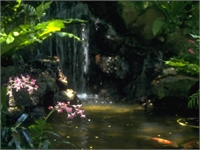
Ahupuaa
Important Notice: Our web hosting provider recently started charging us for additional visits, which was unexpected. In response, we're seeking donations. Depending on the situation, we may explore different monetization options for our Community and Expert Contributors. It's crucial to provide more returns for their expertise and offer more Expert Validated Answers or AI Validated Answers. Learn more about our hosting issue here.
A visit to Hawaii these days is a learning experience for most westerners. The Hawaiians never used money to transact trade, never took title to land, and never had a welfare system. It was very non-western in that respect. Their civilization lasted 1,500-2,000 years (the first arrival to the Hawaiian islands being around the birth of Christ.)
One of the secrets for this successful, stable socio-economic system was in the way they managed their most important resource, land. Land (aina) that much taken-for-granted resource in other cultures, was nurtured for the plant products (food, medicines, building material, weaponry, etc.), its fresh water streams, and housing that it could support. Tribal battles and wars were fought over prime, fertile sections of the islands in times of overpopulation and famine. In ancient Hawaii, a commoner (maka’ainana) didn’t own the land, the Hawaiian gods did. He was permitted to work the land, like an indentured servant, and offered part of his yield to the chief in charge. Chiefs, or ali’i, were technically the human representative of the gods on earth or stewards of the land. Their job was to manage how the maka’ainana utilize the land use for the welfare of the entire community. The ancient use of the land was a concept of an island within an island.
Imagine that you were shipwrecked on a deserted island. The island was blessed with steady rainfall and good fertile soil. Rainfall runoffs formed pools, waterfalls, and streams. From your ship, you secured a seeds of economic plants that bore products that provided you with food, medicines, weapons, cloth, and housing. Because you are by yourself, you work only a portion of the island’s land area. This section of land was what the Hawaiians called and ahupua’a. Only in ancient times, the whole island was sectioned into individual ahupua’as and you had fellow inhabitants assigned and living and working on a sector. Put simply, it was a co-op community. The ahupua’a land division was always from the tops of the mountains to the coast. This gave the residents of the community the widest latitude for utilizing natural resources, climate and temperate zones within that area. The sides of the ahupua’a were natural landmarks, like the ridges, valleys or streams.
Ahupua’a literally translate into pig altar. This is because a stone altar marked the entrance to each neighborhood ahupua’a at the coast. This altar was used to place offerings (or taxes) in the form of finished goods and food for the chiefs. Taxes were paid each year to the chiefs during the period from October to early February called Makahiki.
On the island of Oahu, the H-3 freeway that goes from the leeward to the windward side of the island. It got approval to be built in 1960 and wasn’t completed until December 1997. It cuts through the Halawa valley (Halawa Ahupua’a in ancient times) to the southern side of the Koolau mountain range and through the Haiku valley on the other side. It is one of the most expensive freeways in the nation, costing $1.3 billion for about 12 miles of freeway. One reason for the high cost was that construction was delayed for almost 40 years. The Halawa valley is rich in ancient Hawaiian archeological finds. Prior to European discovery, Halawa ahupua’a was a thriving community. If you take a drive over the H-3 freeway, you’ll experience a textbook example of the concept of the ahupua’a. The H-3 starts in the lowlands near Pearl Harbor and ascends some 3,000 feet above sea level over to the other side. As you travel through the Halawa valley, you’ll see how the vegetation changes with altitude. The resources available at the different altitudes, the fresh water streams, and climatic growing conditions and soil, was what the inhabitants of an ahupua’a pooled and distribution among themselves. It was a true distribution of resources for the benefit of all.